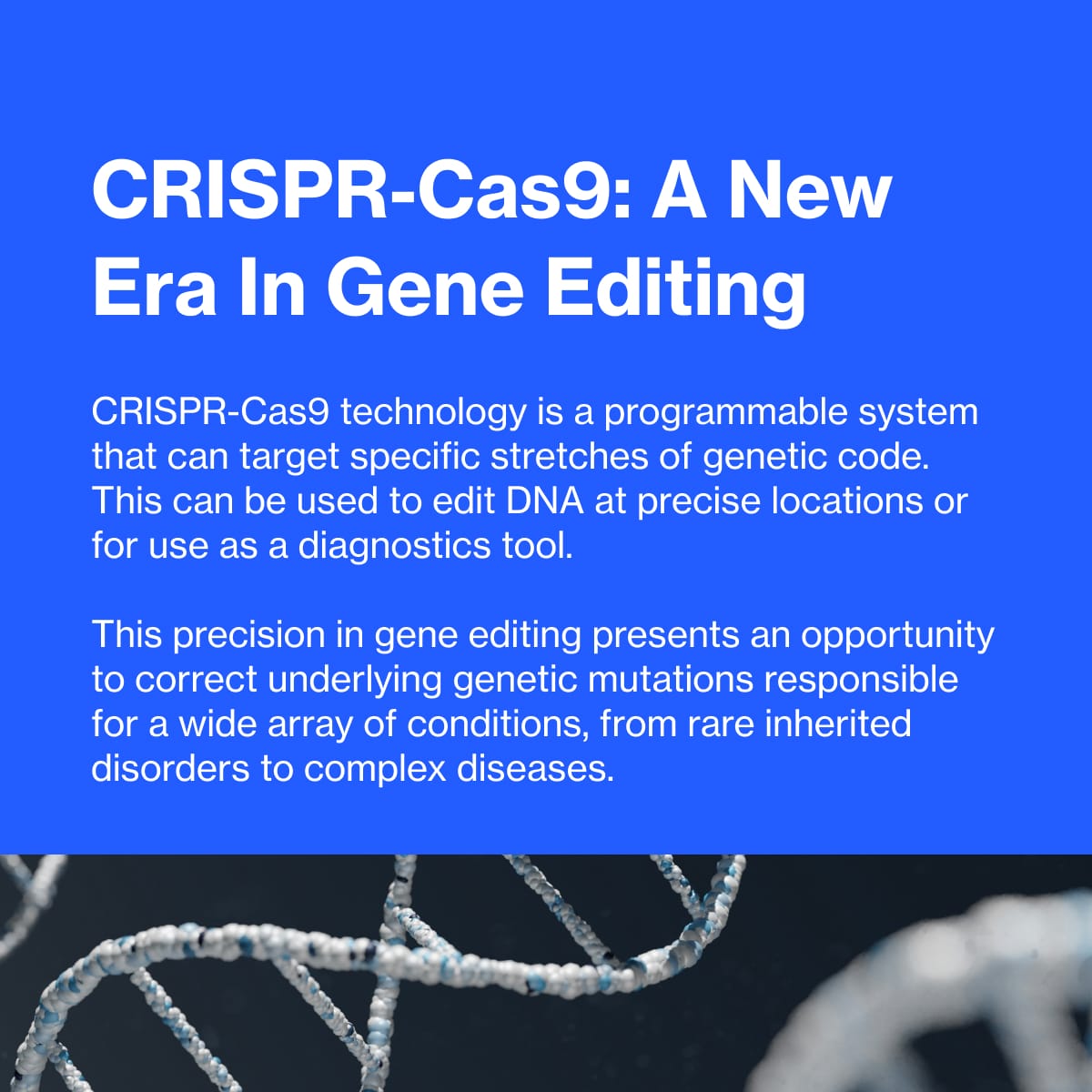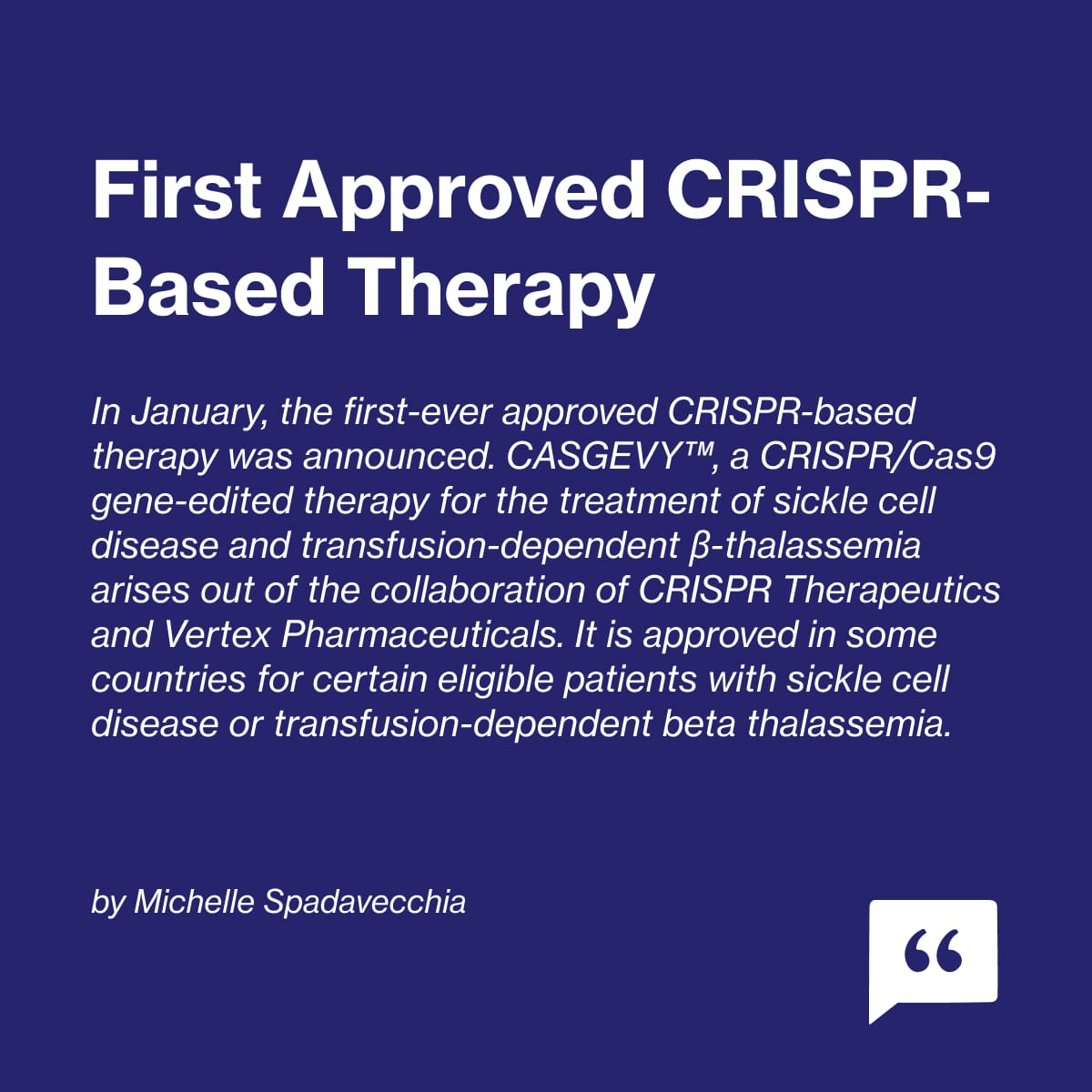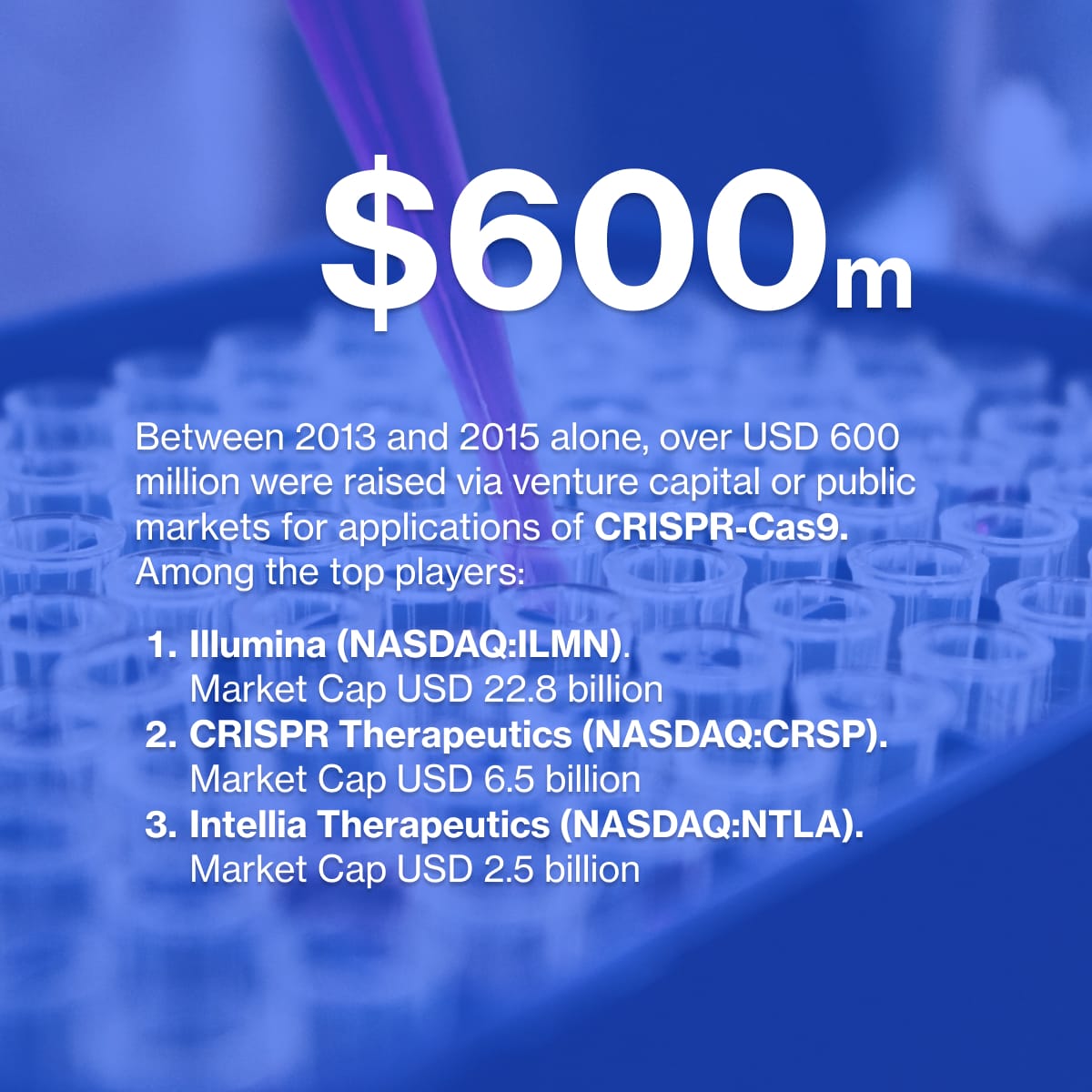The Future of Precision Medicine: CRISPR-Cas9







- CRISPR technology represents a groundbreaking approach to treating genetic disorders and other diseases at their root cause.
- Between 2013 and 2015 alone, over USD 600 million were raised via venture capital or public markets for applications of CRISPR-Cas9.
- Some of the best outcomes of the applicability of CRISPR are in treating conditions such as sickle cell disease, HIV, beta thalassemia, Duchenne muscular dystrophy, and different types of cancer.
- In January, the first FDA-approved CRISPR-based therapy was announced.
- Some of our top existing indices related to Gene Editing and CRISPR, such as the Messenger RNA Technology NTR Index (BMRNAIN) and US Biotech Giants Index (BUBIOG) are available for licensing and for use in BITACore index testing platform.
Imagine you were living in the 90s, and your future self comes back to tell you that someday, a computer that fits in your pocket will be able to take care of most of your daily needs and tasks. From activities like shopping or cleaning to making appointments or even investment decisions. Imagine the whole world connected through a network. Wouldn’t it have sounded unlikely? Well, it happened. And now, in 2024, we are seeing similar breakthroughs in Genetic Engineering.
Humans have practiced genetic engineering for thousands of years through crop and livestock breeding, much of that time with only minimal knowledge of how genetics work (Roots, C., 2007). Until we discovered the code of life: Desoxyribonucleic Acid (DNA). DNA -the familiar image of a complex molecule resembling two spiral ladders- guides every living organism’s growth, development, functions, and reproduction. If any information codified in the DNA is modified, the organism will be modified too.
LONG STORY SHORT
With the discovery of DNA’s structure by Watson and Crick in 1953, our understanding of genetic material grew substantially. New methods directly targeting DNA saw the light of day, starting with mutation breeding around 1960 to later using recombinant DNA technology or GM technology in 1983. An experiment took place in the 60s in which some pea plants were radio-stimulated to cause random variations in their DNA, with the idea of obtaining a genetic improvement, and guess what? It worked, and more than once.
Commercialization of GM began in the 80’s, with a patent of Chakrabarty companies with modified oil-eating microbes for bioremediation. While DNA technologies grew by leaps and bounds through the 1960’s, 70’s and 80’s, we now manufacture many life-saving products made possible by genetic engineering, such as vaccines, human growth hormones, and insulin.
EVOLUTION AND FUTURE OF GM AND THE ROLE OF CRISPR
The realm of gene-editing technologies has fundamentally revolutionized biomedical research and development by providing new tools that can accurately edit an organism’s genome, whether human, pathogen, or animal model. One of the most groundbreaking and impactful of these new tools is CRISPR-Cas9 (Clustered Regularly Interspaced Short Palindromic Repeats): systems that can be programmed to target specific stretches of genetic code to edit DNA at precise locations or for use as a diagnostics tool. This technology emerged in 2012 at the hands of chemist Jennifer Doudna and microbiologist Emmanuelle Charpentier, and this system rapidly converted into the major focus in biotechnology due to its capacity, precision, and ease of use.
CRISPR technology represents a groundbreaking approach to treating genetic disorders and other diseases at their root cause. With its ability to precisely edit DNA sequences, CRISPR has captured scientists, healthcare professionals and the public alike, offering the promise of transformative therapies that are changing the landscape of modern medicine. At its core, this technology harnesses the natural defense mechanism found in bacteria to target and modify specific genetic sequences within human cells. This kind of precision in gene editing presents an unprecedented opportunity to correct underlying genetic mutations responsible for a wide array of conditions, from rare inherited disorders to complex diseases.
Most companies working with CRISPR focus on human therapeutics or biotechnology development & research, with some other applications in industrial biotech and bio-agriculture. A sign of increasing investment in CRISPR technologies is the increasing number of patents filed on CRISPR technologies from leading companies like:
1. CRISPR Therapeutics (NASDAQ:CRSP)
2. Editas Medicines (NASDAQ:EDIT)
3. Merck (XETRA:MRK)
4. Regeneron Pharmaceuticals (NASDAQ:REGN)
5. Intellia Pharmaceuticals (NASDAQ:NTLA)
6. Beam Therapeutics (NASDAQ:BEAM)
7. Caribou Biosciences (NASDAQ:CRBU)
8. Vertex Pharmaceuticals (NASDAQ:VRTX)
Between 2013 and 2015 alone, over USD 600 million were raised via venture capital or public markets for applications of CRISPR-Cas9. Among the top players:
1. Illumina (NASDAQ:ILMN). Market Cap USD 22.8 billion
2. CRISPR Therapeutics (NASDAQ:CRSP). Market Cap USD 6.5 billion
3. Intellia Therapeutics (NASDAQ:NTLA). Market Cap USD 2.5 billion
The global CRISPR Technology market reached $3.4 billion in 2023 and is poised to reach $7.1 billion by 2028, with a compound annual growth rate (CAGR) of 15.6% during the forecast period of 2023-2028.
Some of the best outcomes of the applicability of CRISPR are in treating conditions such as sickle cell disease, HIV, beta thalassemia, Duchenne muscular dystrophy, and different types of cancer. Early studies and preclinical research have demonstrated encouraging results, pointing to the potential for these therapies.
In 2023, Illumina announced their new PrimateAI-3D, an artificial intelligence (AI) algorithm that is capable of predicting with unprecedented accuracy disease-causing genetic mutations in patients. This technology combines AI technology with the most advanced DNA sequencing capabilities, assisting researchers to keep up with the vast quantities of genomic data being generated from this platform that holds the potential to exponentially accelerate the critical work underway to better serve patients. The PrimateAI-3D algorithm was applied to identify rare pathogenic mutations in nearly half a million individuals in the UK Biobank. The algorithm also improves the accuracy of genetic risk predictions, a crucial move towards the implementation of genetic-based precision medicine for diverse populations.
In January, the first-ever approved CRISPR-based therapy was announced. CASGEVY™, a CRISPR/Cas9 gene-edited therapy for the treatment of sickle cell disease and transfusion-dependent β-thalassemia arises out of the collaboration of CRISPR Therapeutics and Vertex Pharmaceuticals. It is approved in some countries for certain eligible patients with sickle cell disease or transfusion-dependent beta-thalassemia.
Large, global pharmaceutical companies such as Pfizer, Merck, and Novartis are researching and collaborating to access novel CRISPR technology platforms.
The ongoing development and refinement of CRISPR-based treatments have raised optimism within the medical community, patients, and their families. As clinical trials continue, and the safety and efficacy of CRISPR therapies are evaluated, the potential for these interventions to become viable treatment options grows much closer than ever before.
Ensuring the safety and efficacy of CRISPR-based treatments is a consideration as well. Addressing potential adverse effects of gene editing and navigating regulatory approvals are all critical aspects of advancing technology toward widespread clinical use.
BITA’s Proprietary Data Team tracks and researches companies committing resources to research and development in gene-editing technologies and other biotechnology advancements. The thematic universes offer investors granular information based on revenue exposure to each related subtheme and product, service, activity creating ease of investment in very specific, custom-crafted areas. Through using the BITACore index creation platform or Bita live indexes, clients are able to direct capital to their own custom rule-based portfolios with quarterly rebalancing based on the ongoing research of Bita’s Proprietary Data Team.
BITA Messenger RNA Technology NTR Index (BMRNAIN)
BITA US Biotech Giants Index (BUBIOG)
REFERENCES
History of Genetic Engineering and the Rise of Genome Editing Tools. https://www.synthego.com/learn/genome-engineering-history
International Atomic Energy Agency. Mutation Induction. https://www.iaea.org/topics/mutation-induction#:~:text=Since%20the%201960s%2C%20gamma%20rays,irradiated%20in%20X%2Dray%20machines.
Khoshandam, M. and Soltaninejad, H. (2024). Clinical applications of the CRISPR/Cas9 genome-editing system: Delivery options and challenges in precision medicine. https://www.sciencedirect.com/science/article/pii/S235230422300079X
MarketsAndMarkets. (2019). CRISPR Market. https://www.jstor.org/stable/24927704
Mulhollem, J. (2019). Unraveling of 58-year-old corn gene mystery may have plant-breeding implications. https://www.psu.edu/news/research/story/unraveling-58-year-old-corn-gene-mystery-may-have-plant-breeding-implications/
Myelnikov, D. (2019). Tinkering with genes and embryos: the multiple invention of transgenic mice c. 1980. https://www.ncbi.nlm.nih.gov/pmc/articles/PMC7035111/
PR Newswire. Illumina unveils AI software to predict disease-causing genetic mutations in patients. https://www.prnewswire.com/news-releases/illumina-unveils-ai-software-to-predict-disease-causing-genetic-mutations-in-patients-301840484.html
Roots, C. (2007). Domestication. https://www.abebooks.com/servlet/BookDetailsPL?bi=31659183386&cm_sp=snippet-_-srp1-_-tile2&searchurl=an%3Droot%2Bclive%26ds%3D10%26sortby%3D17
Select Science. What next for CRISPR after first therapeutic approvals? https://www.selectscience.net/editorial-articles/what-next-for-crispr-after-first-therapeutic-approvals/?artID=60554
Sigurbjörnsson, B. (1971). Induced Mutations in Plants. https://www.jstor.org/stable/24927704
Tamura, R. and Toda, M. (2020). Historic Overview of Genetic Engineering Technologies for Human Gene Therapy. https://www.ncbi.nlm.nih.gov/pmc/articles/PMC7555159/
Udhaya, K. (2023). Current trends of clinical trials involving CRISPR/Cas systems. https://www.frontiersin.org/articles/10.3389/fmed.2023.1292452/full

